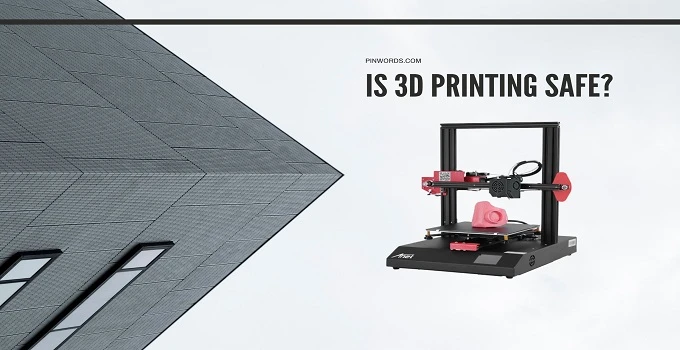If you have this question in your mind, "Is 3D printing safe?" we can say that this question has no particular answer.
People around the world have been printing attractive 3D models, so the process can be considered safe, otherwise, they wouldn't have done it in the first place.
At the same time, it is not safe if you are not being careful enough during the printing process. For instance, touching the printer nozzle while it is still insanely hot can burn your hands! Not only that but also some filaments give off toxic fumes that can make you feel uncomfortable.
Okay, so let's take a look in detail at the safety concerns regarding 3D printing in this guide.
Contents

PLA is a non-toxic 3d printer filament as it is biodegradable and is derived from plant-based starch, like corn and sugarcane. It is because of these natural resources that you get a sweet-smelling aroma during the printing process.
However, like any other filament, it has the potential to be toxic if you inhale the fumes for prolonged periods. Even people who are sensitive to the air quality might experience discomfort while printing with PLA.
PLA is generally considered food-safe, which means you can use it to print kitchen utensils, like bowls and spoons, and then let the food come in contact.
However, there are some risks you will need to keep in mind when using 3D printed PLA for handling food:
When you consider using 3D-printed material for food, you will obviously want it to be free from germs and bacteria. The presence of such organisms will not only contaminate the food but also can cause illness.
If the 3D printed object has small cracks and sharp edges, there is a higher risk of bacteria inhabiting it, especially after food particles get stuck in them. While this won't be much of an issue for disposable use, it can affect health when you use it in the long run.
In order to prevent the accumulation of bacteria, you can either print an object having a smooth finish and less complicated design or use a food-safe sealant to block the cracks and crevices.
While you can't go wrong with the fact that natural PLA is food-safe, identifying it can be complicated.
That's because some manufacturers will incorporate certain additives for enhancing its color and strength. As a result, that will make the material unsafe for food contact.
So, when you are in doubt of the filament's composition, you will need to check the safety data sheet. If you find that it has no additives, and is FDA-approved, then it is indeed food-safe.
It's no surprise that PLA can get easily contaminated by the hot-end of your 3D printer.
The 3D printing process involves a mixture of heat and chemicals, which can affect your health. Desktop 3D printers with PLA release ultra-fine particles that stick to the printed surface. If you inhale or consume these particles excessively, it can have negative consequences on your health.
If you've been thinking about throwing your PLA utensils into the dishwasher, you better put your thoughts aside.
PLA is not dishwasher-safe, which means if you put your PLA utensils in it, they can melt or warp at high temperatures, thus letting all the hard work go to waste!
What you can do instead is use lukewarm water and mild detergent to remove all the bacteria accumulating on the surface of your 3D prints.
Nylon filament is known for its durability and flexibility, which makes it an ideal candidate for 3D printing objects that require such characteristics. It requires extruder temperatures ranging between 220 and 250 degrees Celsius, depending on the filament brand.
Although this type of filament is stronger than PLA and ABS, it requires caution in order to prevent health issues. Nylon is found to emit a toxic volatile organic compound called Caprolactam, which can cause irritation to the eyes and damage the respiratory system.
If your job requires 3D printing on a regular basis, the first and foremost thing you should do is to protect yourself during operation. Here are some tips you can follow in order to minimize the risks of those harmful fumes affecting your health:
If you are printing in your home office or bedroom, you will need to ensure there is proper ventilation. Ideally, you can keep the window open and place the 3D printer close to it.
If you don't want to leave the windows open, especially at night due to bugs, you can consider investing in an air purifier.
It is best to go for an air purifier with HEPA filtration and activated charcoal as they filter out the microscopic particles and volatile organic compounds released by specific filaments. As a result, you won't be getting any unpleasant smell that you normally would.
Some 3D printers come with an enclosure that you can use during the printing process to protect yourself from unpleasant smells. Other than that, you can keep your 3D printer enclosed if you don't want to be bothered by its noises, prevent children and pets from getting close to the printer, or minimize warping issues.
So is 3D printer filament toxic and what to do to counter that? We hope this article was able to give you some insights about safety concerns.
3D printing is really an interesting activity because you have the freedom of printing any object you want- whether it is an earphone case, an orrery, or a drawing machine. By creating such models, you can save dollars in buying actual objects and also surprise people around you with your fantastic creations!
That being said, you will need to take necessary precautions during the printing process. If you get injured, then who will take care of the rest, right?
If you found this article helpful, then don't forget to share it with other 3D printing enthusiasts!



 |
 |
 |
 |
Check These Out